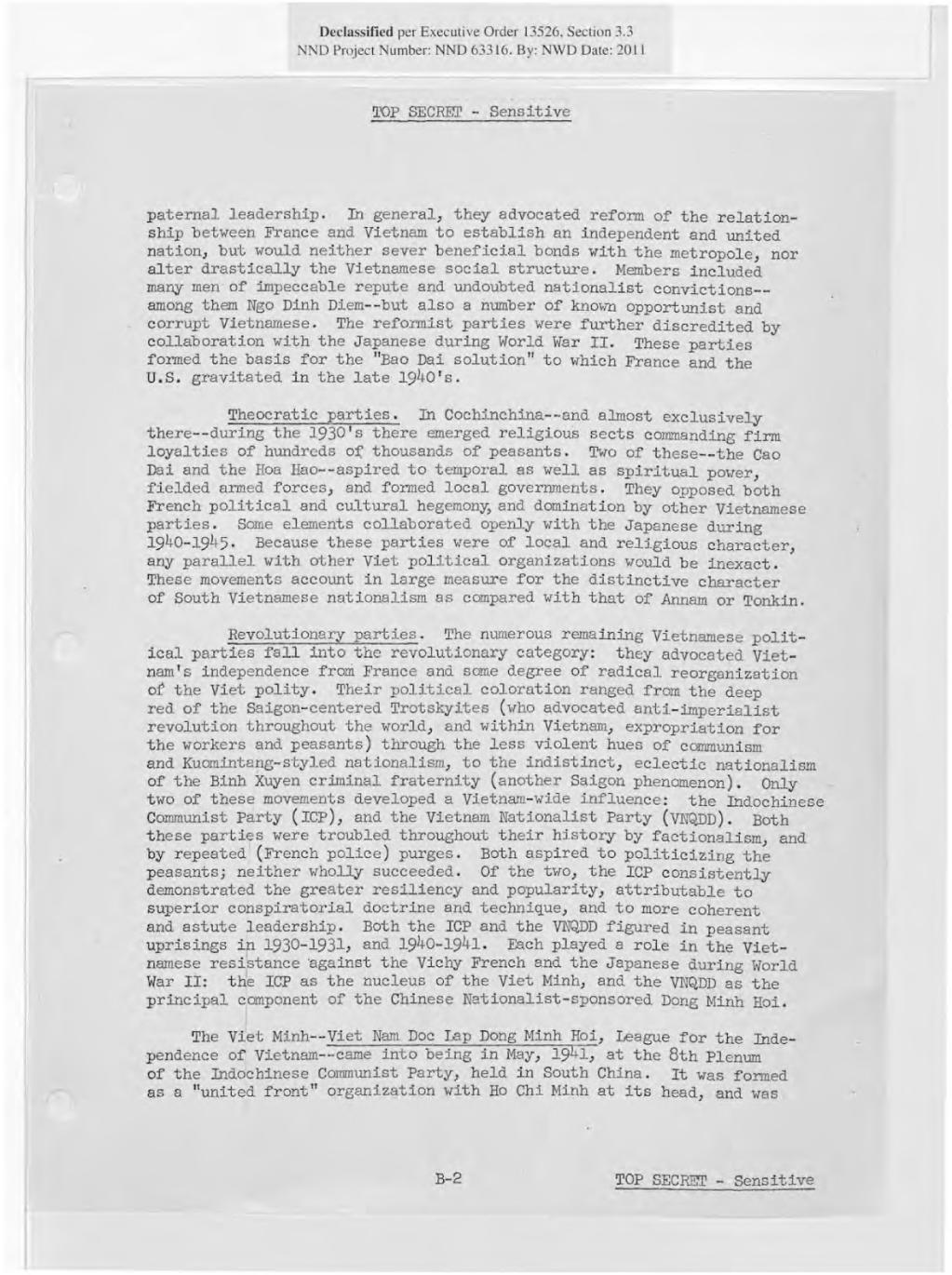Declassified per Executive Order 13526, Section 3.3
NND Project Number: NND 63316. By: NWD Date: 2011
TOP SECRET – Sensitive
paternal leadership. In general, they advocated reform of the relationship between France and Vietnam to establish an independent and united nation, but would neither sever beneficial bonds with the metropole, nor alter drastically the Vietnamese social structure. Members included many men of impeccable repute and undoubted nationalist convictions—among them Ngo Dinh Diem—but also a number of known opportunist and corrupt Vietnamese. The reformist parties were further discredited by collaboration with the Japanese during World War II. These parties formed the basis for the "Bao Dai solution" to which France and the U.S. gravitated in the late 1960's.
Theocratic parties. In Cochinchina—and almost exclusively there—during the 1930's there emerged religious sects commanding firm loyalties of hundreds of thousands of peasants. Two of these—the Cao Dai and the Hoa Hao—aspired to temporal as well as spiritual power, fielded armed forces, and formed local governments. They opposed both French political and cultural hegemony, and domination by other Vietnamese parties. Some elements collaborated openly with the Japanese during 194O–1945. Because these parties were of local and religious character, any parallel with other Viet political organizations would be inexact. These movements account in large measure for the distinctive character of South Vietnamese nationalism as compared with that of Annam or Tonkin.
Revolutionary parties. The numerous remaining Vietnamese political parties fall into the revolutionary category: they advocated Vietnam's independence from France and some degree of radical reorganization of the Viet polity. Their political coloration ranged from the deep red of the Saigon-centered Trotskyites (who advocated anti-imperialist revolution throughout the world, and within Vietnam, expropriation for the workers and peasants) through the less violent hues of communism and Kuomintang-styled nationalism, to the indistinct, eclectic nationalism of the Binh Xuyen criminal fraternity (another Saigon phenomenon). Only two of these movements developed a Vietnam-wide influence: the Indochinese Communist Party (ICP), and the Vietnam Nationalist Party (VNQDD). Both these parties were troubled throughout their history by factionalism, and by repeated (French police) purges. Both aspired to politicizing the peasants; neither wholly succeeded. Of the two, the ICP consistently demonstrated the greater resiliency and popularity, attributable to superior conspiratorial doctrine and technique, and to more coherent and astute leadership. Both the ICP and the VNQDD figured in peasant uprisings in 1930–1931, and 1940–1941. Each played a role in the Vietnamese resistance against the Vichy French and the Japanese during World War II: the ICP as the nucleus of the Viet Minh, and the VNQDD as the principal component of the Chinese Nationalist-sponsored Dong Minh Hoi.
The Viet Minh—Viet Nam Doc Lap Dong Minh Hoi, League for the Independence of Vietnam—came into being in May, 1951, at the 8th Plenum of the Indochinese Communist Party, held in South China. It was formed as a "united front" organization with Ho Chi Minh at its head, and was
